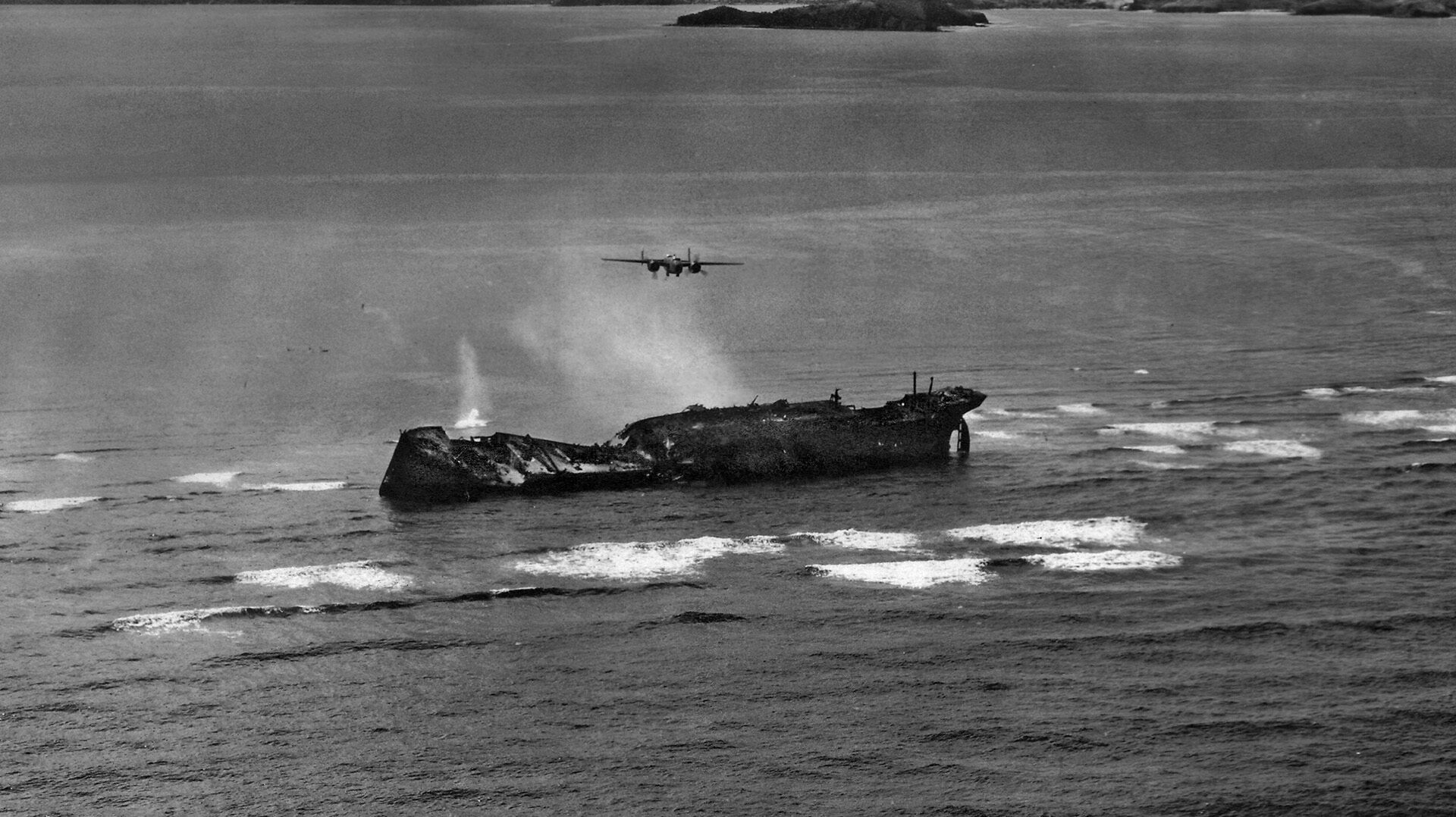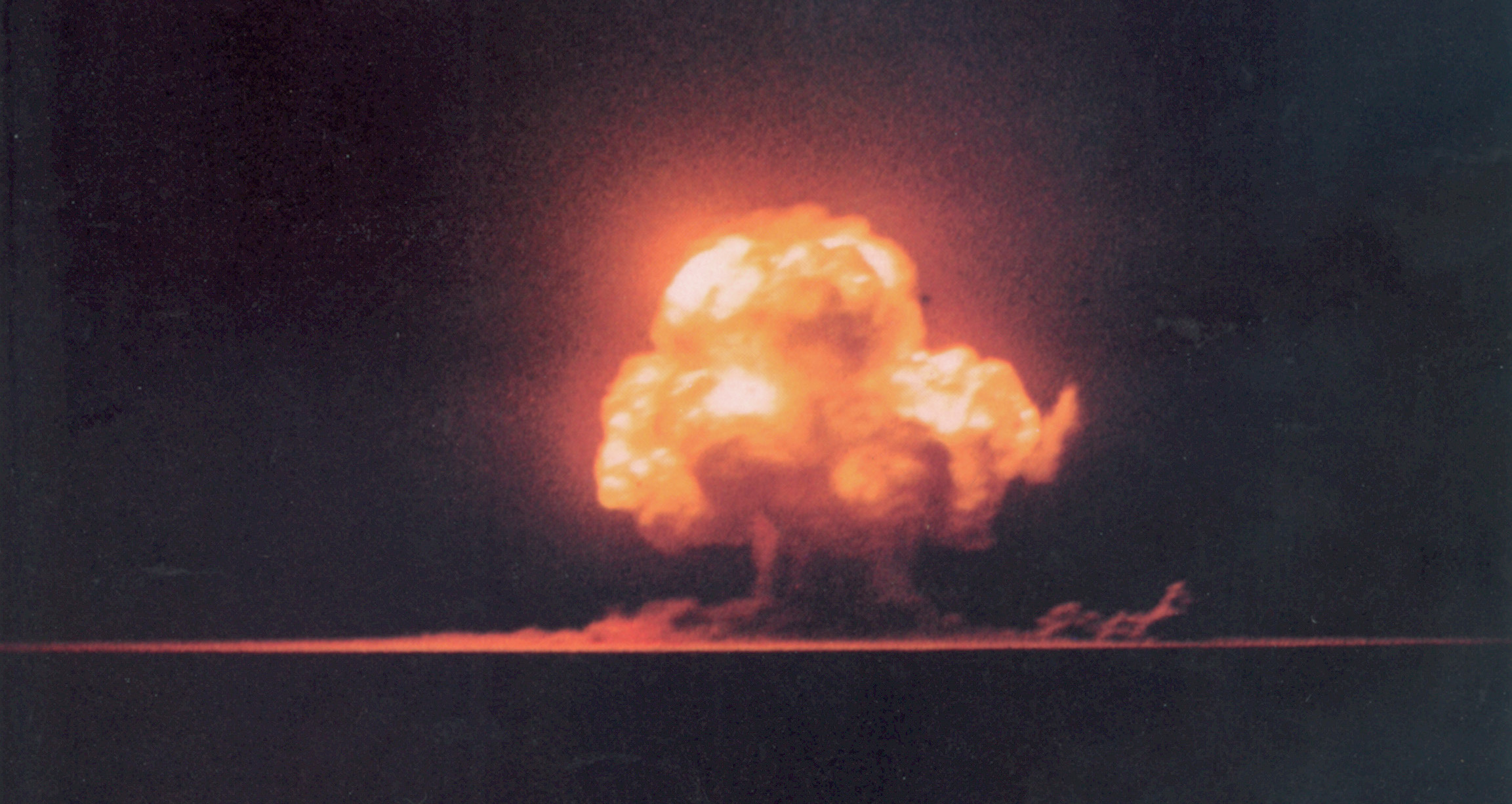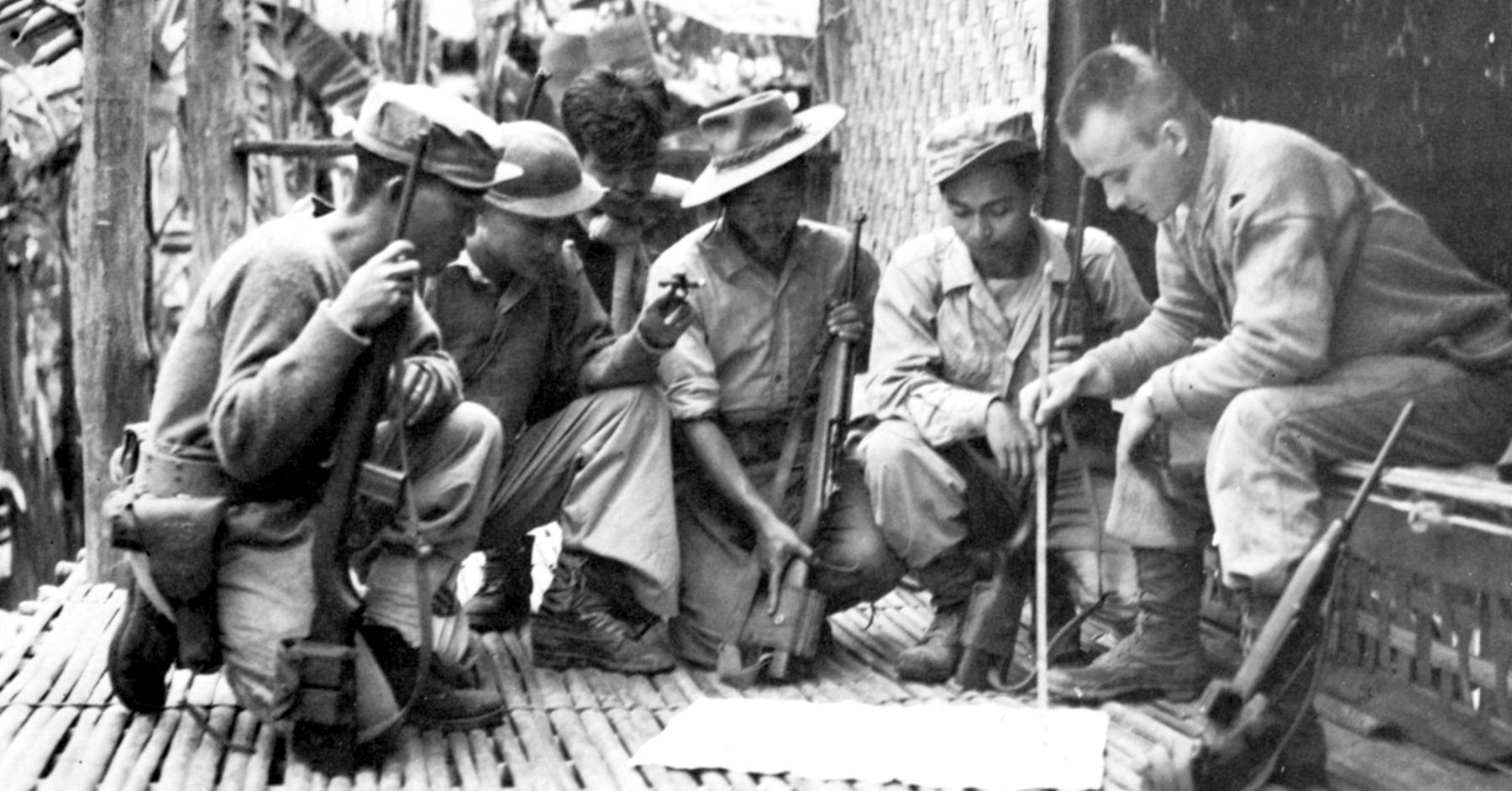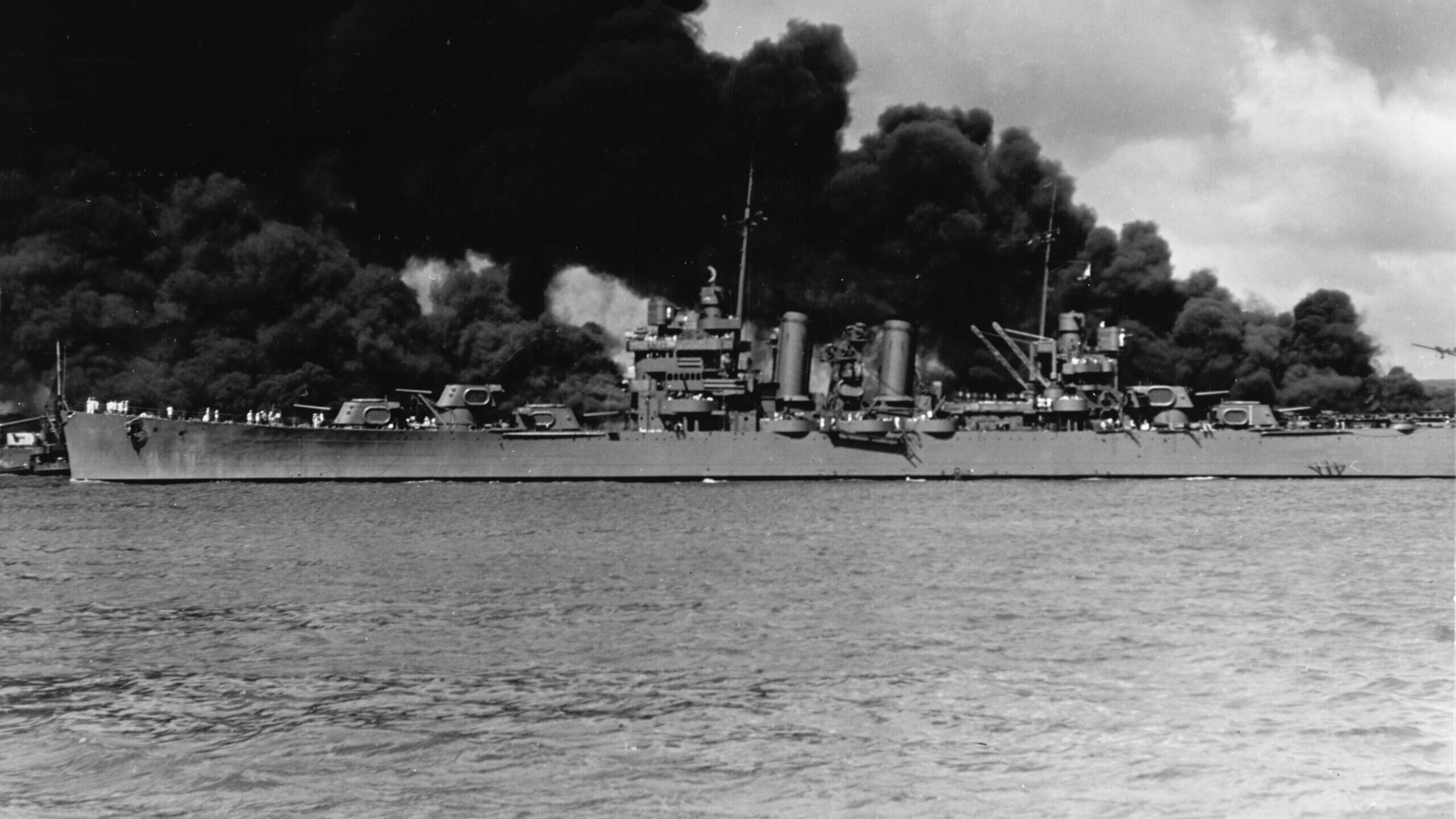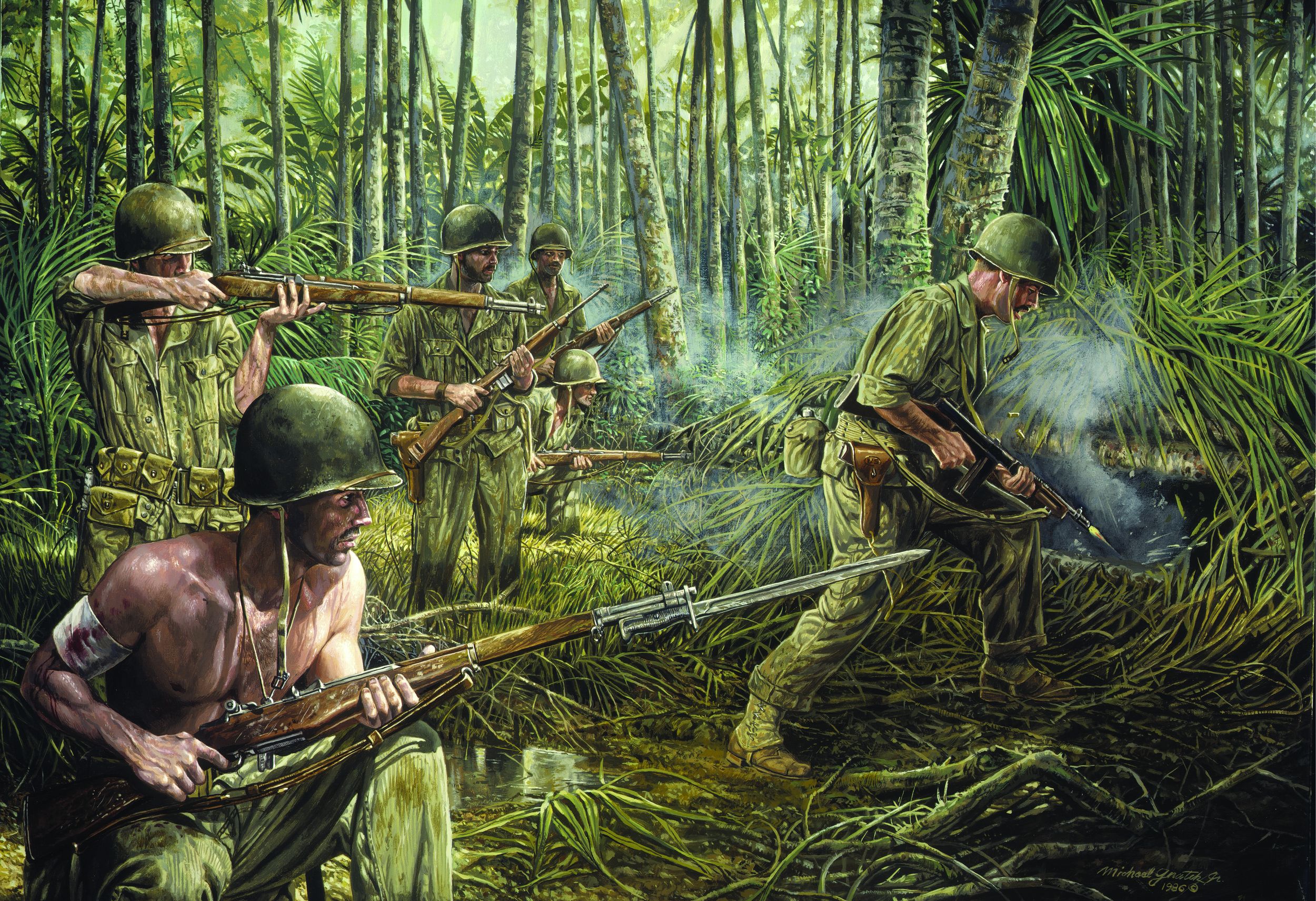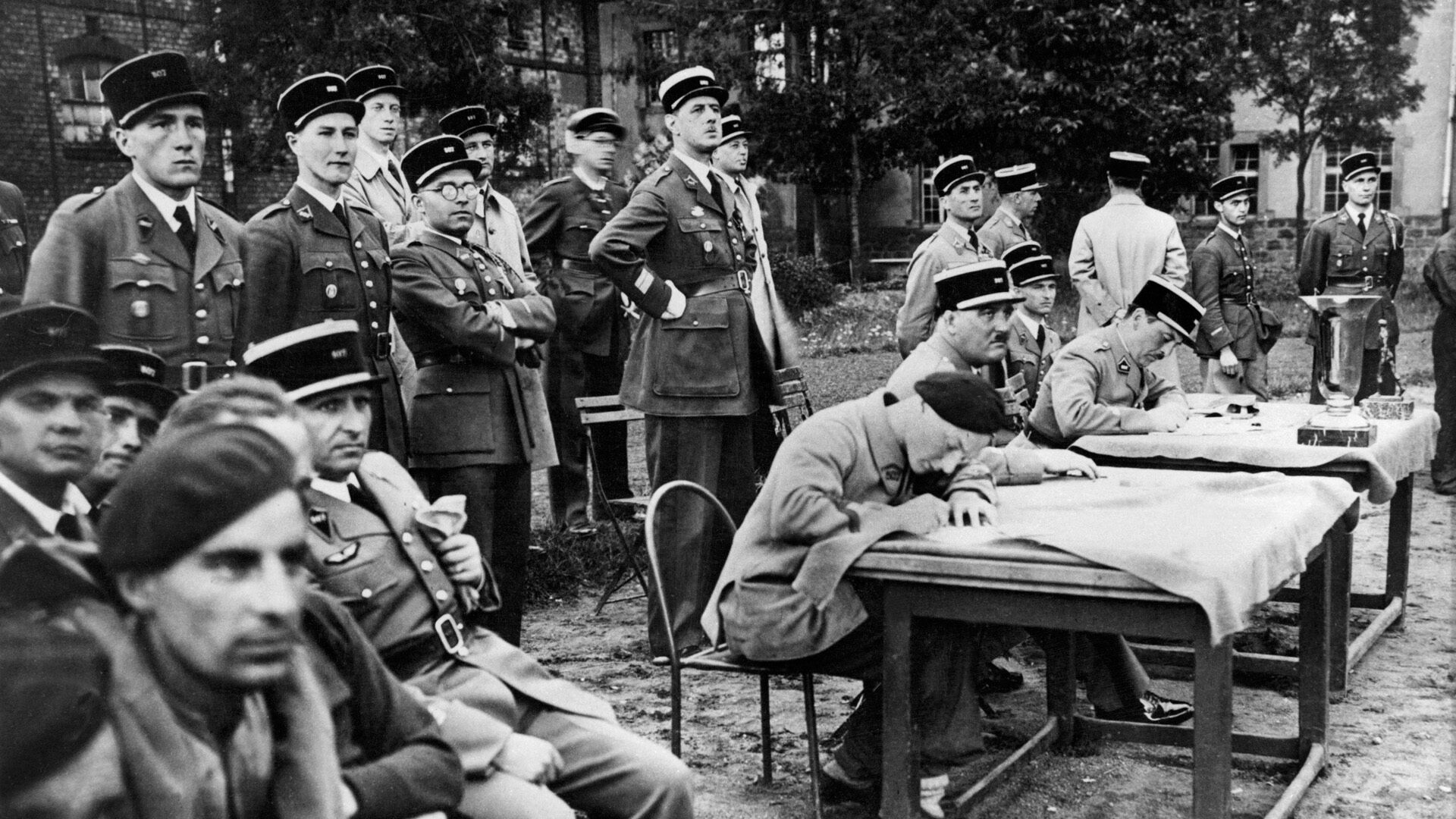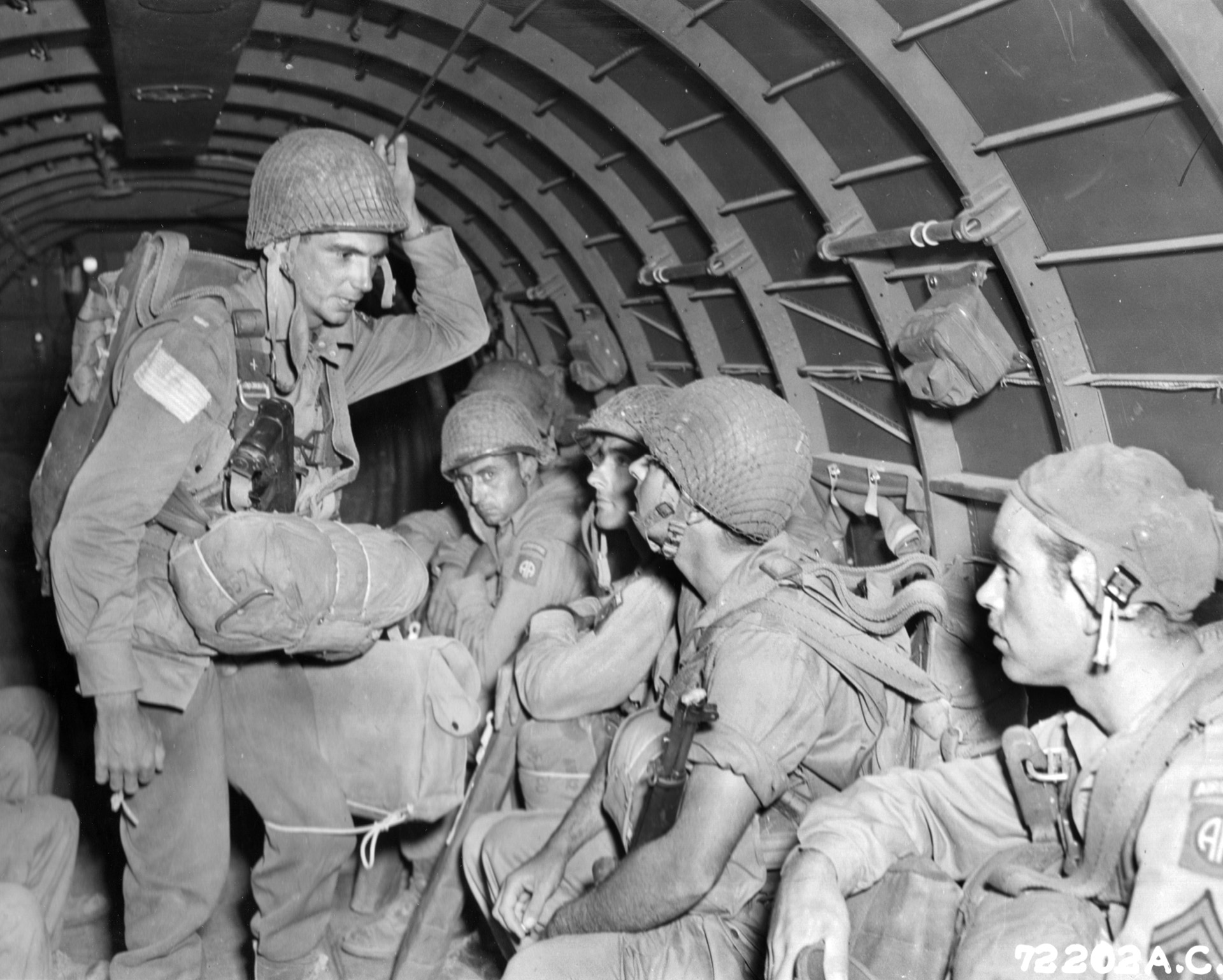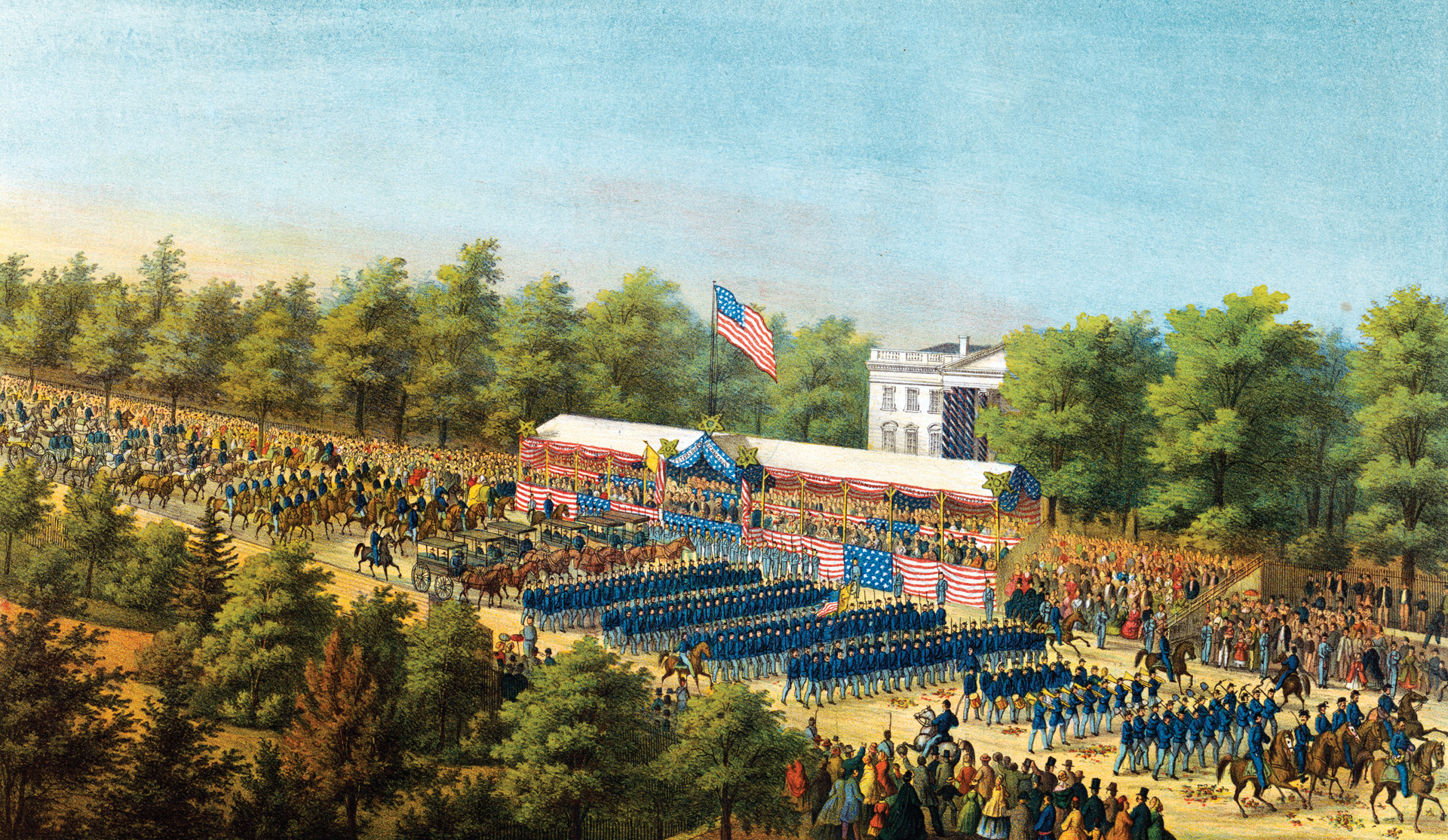By Gene Eric Salecker
By September 1942, after numerous aerial strikes against the advancing Imperial Japanese Navy, the Battle of the Coral Sea in May, and numerous attacks against enemy convoys along the New Guinea coast in the summer of that year, Maj. Gen. George Kenney was convinced that it was too hard to hit a moving ship from high altitude with his four-engine Boeing B-17 Flying Fortress heavy bombers.
General Kenney had taken over General Douglas MacArthur’s air force on July 29, 1942, and had found the situation in shambles. Kenney discovered that after almost a year of trying to stop the advancing Japanese juggernaut most of the men belonging to the 19th Bomb Group (BG), which had retreated from the Philippines, were in desperate straits. “The crews were thinking only of going home,” Kenney commented. “Their morale was at a low ebb and they didn’t care who knew it.” Out of the 32 B-17s based at Mareeba Airfield at the base of Australia’s York Peninsula, General Kenney discovered that only 14 were combat ready, with the others waiting for repairs or parts or both. All 32 airplanes, however, were battered and worn. “Anywhere else but this theater,” he wrote, “they would probably have been withdrawn from combat, but they were all we had so I’d have to use them if we wanted to keep the war going.”
In spite of this deplorable first impression, Kenney worked hard and had 16 B-17s ready to attack the strong Japanese air and naval base at Rabaul on the northern tip of New Britain island on August 7, 1942, in conjunction with the Marine Corps attack on Guadalcanal. The town of Rabaul sat on the northern end of Blanche Bay. The bay’s entrance was four miles wide, and the entire bay was deep enough to take any ocean-going man-of-war. Inside the bay, directly below Rabaul, was horseshoe-shaped Simpson Harbor. After capturing the town and harbor from the Australians in January 1942, the Japanese had turned Rabaul into a major base complex that included the excellent deep-water harbor and two nearby airfields, Lakunai, almost immediately southeast of the town and harbor, and Vunakanau, nine miles almost due south. On August 7, 1942, the 19th BG struck Vunakanau Airfield for the first time, successfully damaging dozens of planes and drawing attention away from the Marine invasion of the Solomon Islands.
Over the next month, the 19th BG, joined by the 43rd BG, and now part of ’s newly christened Fifth Air Force, struck at Rabaul and at Japanese convoys moving out to reinforce their invasion forces on northern New Guinea. With the B-17s dropping their bombs from at least 25,000 feet, the Japanese ships had plenty of time to move out of the way of the falling bombs before the projectiles reached water level. It was estimated that less than one percent of all bombs dropped from high altitude on moving ships actually hit their mark. To be more effective, something had to change.
Back in July, General Kenney and his aide, Major William Benn, had discussed the possibility of low-level skip bombing attacks from about 50 feet altitude. When the bomber was about 100 feet away from the target ship, it would release a bomb that would skip across the surface of the water, like a flat pebble skipping across the surface of a lake, until it bumped into the side of the vessel. Then, with a five-second delay fuse, the bomb would sink beneath the ship and blow a hole in the hull when it detonated.
The idea of skip bombing had originated with the British, but they had been unsuccessful in perfecting the technique and had abandoned its use as being too dangerous. Reviving the idea, General Kenney and Major Benn began experimenting. According to Lieutenant James T. Murphy, “Major Benn and General Kenney had originally thought that bombing enemy ships at extremely low altitude could only be accomplished by a medium bomber—the A-20, B-25, or B-26.” The three planes all mounted forward-firing machine guns, which was thought to make them perfect for coming in at a low altitude against an enemy vessel before dropping their bombs. After a few trial runs, the two men realized that “experiments and a lot of practice would be required,” and that “the aircraft would be shot down coming in during daylight hours if the Japanese ships had much gun protection on their decks.”
Still believing that they could make skip bombing work, General Kenny removed Major Benn from his staff and placed him in charge of the 63rd Bomb Squadron (BS), part of the newly formed 43rd BG. Reported Lieutenant Murphy, “Benn was given full authority from General Kenney to develop low-altitude and skip bombing for use against Japanese ships.” Both Kenney and Benn knew that their best chance to destroy Japanese ships was to hit them when they were anchored at their home base, Rabaul. Although both men wanted to use medium bombers for skip bombing, they knew that only their big four-engine B-17 bombers had sufficient range to strike the Japanese at Rabaul. Commented Murphy, “Therefore, they had no choice. The Allies had to stop the Japanese freedom of movement on the seas and hit them at the major Southwest Pacific installation.”
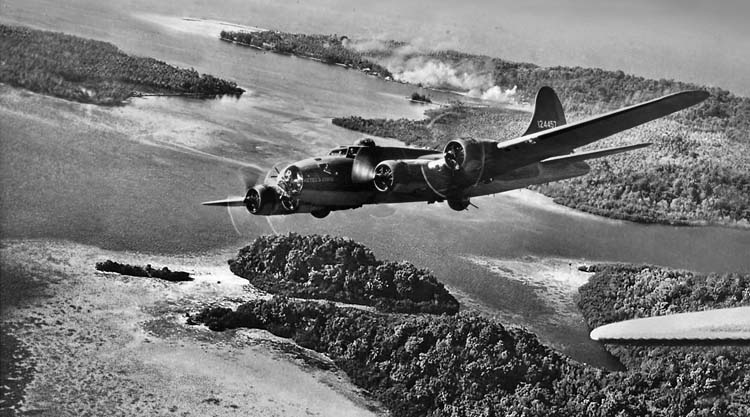
Major Benn began by looking for the right fuses. He started using Australian 10- and 12-second delay fuses. Lieutenant Murphy, a member of Major Benn’s 63rd BS, recalled, “We started dropping the bomb from 50 feet altitude. We quickly found many things that had to be changed. The altitude was too low—the bomb would almost bounce back at us. The timing accuracy of the supposed 10- and 12-second delay was totally unreliable. The detonation varied from milliseconds to 30 seconds.” Unable to get the correct type of fuses in Australia, Major Benn put in a requisition to Army command in the States while his crews continued to practice their bombing runs.
Experimenting with different size bombs, the crews of the 63rd BS began practicing against the hulk of the SS Pruth,an old freighter that was hung up on a reef just inside the harbor of Port Moresby, New Guinea. Although each pilot preferred his own speed and altitude, the general practice was to fly at approximately 2,000 feet altitude while searching for an enemy ship. Once one was spotted, the B-17 dropped down to about 250 feet and approached the side of the ship in level flight and at a speed of about 220 miles per hour.
Usually, the bombardier dropped the bomb 60 to 100 feet away from the side of the ship. If done correctly, the bomb would hit the surface of the water, skip into the air, strike the side of the vessel, and sink beside it. “From that low altitude,” reported the 43rd BG historian, “the bombs did not have time to point down. Instead they struck the water, still with more forward than downward momentum, skittered across the waves and struck the side of the freighter.” Lieutenant Murphy added, “[After skipping the bomb] I would fly directly over the ship, retaining my same airspeed and altitude. With the 4- to 5-second delay fuse in the bomb, I had time to get away while the bomb sank by the side of the ship. The explosion underwater often broke the ship in half and created almost immediate fire and explosions.”
On the morning of September 20, 1942, General Kenney watched a skip bombing practice off Port Moresby. Captain Ken McCullar proved to be “especially good,” skipping six out of 10 bombs against the side of the Pruth. To get the bombs to detonate at the precise moment, Kenney learned that the aircrews had been able to modify Australian 10- to 12-second fuses to 5-second fuses. Noted Kenney, “So far they worked pretty well. Sometimes they went off in three seconds, sometimes in seven, but that was good enough.” Until the American 5-second fuses arrived, the men would have to rely on the modified Australian fuses. Although Kenney liked what he saw, he knew that it was still too early to risk the skip bombing technique in combat. The 63rd BS was told to keep practicing.
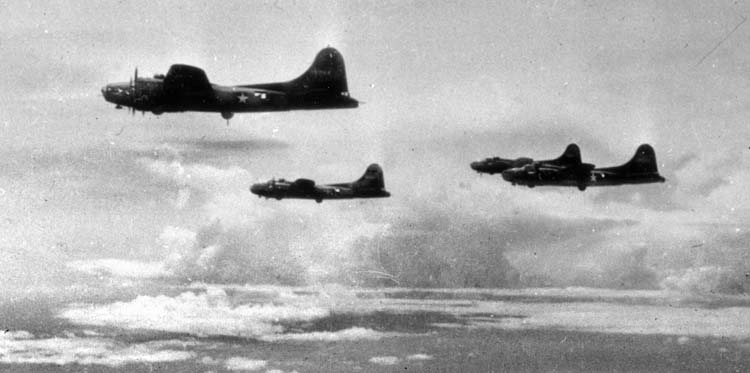
Knowing that Rabaul’s Simpson Harbor was protected by the Japanese planes from Vunakanau and Lakunai airfields, Major Benn stressed to his pilots that their number one advantage was the surprise night attack. Although the Japanese had hundreds of planes based in the Rabaul area in September 1942, they lacked an effective night fighter. Not until May 1943 would the Japanese develop the Nakajima J1N1-C “Gekko” twin-engine night fighter (American codename “Irving”). By that time, however, dozens of ships were already resting on the bottom of Simpson Harbor. “From our first skip bombing mission to our last, we skip bombed only at night,” recalled Lieutenant Murphy. “I made my approach into the rising moon or toward the east at daybreak to catch the first light of day. My bombardier and I could then see the ship before the crew saw us.”
Major Benn instructed his crews to get in and out as quickly as possible to “give them the least amount of time to get a shot at you.” Usually, the crew on the Japanese ship would spot the incoming American bomber at the last minute and attempt to turn their antiaircraft guns toward the low-flying airplane. “They were either too late, or we only received minor damage,” recalled Murphy. “We would then fly directly away without gaining altitude; when at a decent distance over the water, we then began to gain altitude to return home.” Sometimes the B-17 crew went back for a second run against another ship if they had not dropped all of their bombs on the first ship, but as Benn stressed, the planes had to be far away before it got too light. Reported Murphy, “Once it got daylight, we could always expect a mass of fighters to try to find us, so we didn’t stay around very long.”
The highest priority targets for the skip bombing B-17 crews were the Japanese transports. “We have one objective and that is to bomb the Japanese,” stressed Major Benn, “to hurt them where we can, and especially in their shipping—transports, cargo, and whatever protection they have, i.e., warships.” Lieutenant Murphy verified this, writing, “We would be at different altitudes searching for the first priority—Japanese transports and cargo ships.”
The men of the 63rd BS continued to make regular bombing runs against the Japanese infantry at Buna and Gona in northern New Guinea, and at an occasional enemy ship moving along the New Guinea coast, but with whatever spare time was available, they practiced their skip bombing runs against the derelict freighter off Port Moresby. “Even though we were flying missions from Australia into New Guinea,” wrote Murphy, “we practiced skip bombing on the water at Port Moresby between missions. We were always testing our ability to skip bomb for the maximum effectiveness.”
By October 1943, the U.S. Army had begun to supply General Kenney’s Fifth Air Force with American-made fuses. On the night of October 22-23, the first skip bombing raid in American history occurred when the 63rd BS of the 43rd BG attacked a buildup of Japanese shipping at Rabaul. At midnight on October 22, six Fortresses from the 63rd BS took off from Port Moresby behind six from the 64th BS/43rd BG. While the 64th BS hit the town of Rabaul from 10,000 feet, attracting the searchlights and antiaircraft fire, the 63rd BS engaged the enemy ships in skip bombing.
The first successful skip bomber was Captain Franklyn T. Green. Before even entering Simpson Harbor, Green successfully skip bombed a light cruiser and a 5,000-ton cargo ship, then climbed in altitude and entered the harbor where he scored two direct hits on a 15,000-ton cargo ship. As he turned away, Green noted that both cargo ships were sinking and that the light cruiser was on fire with her stern already under water. Minutes later inside the harbor, Captain Carl Hustad skip bombed a 10,000-ton cargo vessel, setting it on fire, while Captain Ken McCullar in B-17F #41-24521 (Black Jack), skipped two bombs into the side of a Japanese destroyer.
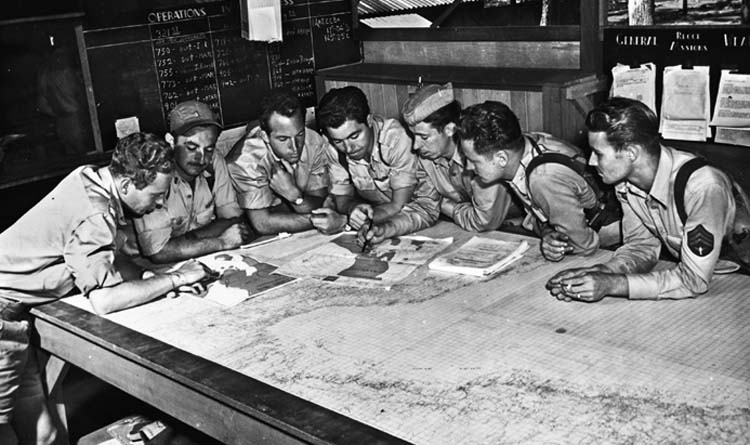
In only a matter of minutes, the 63rd BS had managed to sink or damage at least five Japanese ships. “This was jackpot night,” noted the 63rd BS historian, “and the first use of skip-bombing. It paid dividends.” Informed of the success of the raid, General MacArthur immediately congratulated Major Benn for his persistence in the development of skip bombing and presented him with a Distinguished Service Cross.
Only a few days after the first successful skip bombing mission, General Kenney began sending the first crews from the battered 19th BG home to the United States. The 90th BG, fresh from the United States and flying the longer range Consolidated B-24 Liberator four-engine bombers, was beginning to trickle into Australia and New Guinea. For months General Kenney had promised the 19th BG crews that they would soon be going home, and near the end of October that promise became a reality. Unfortunately, as soon as the 19th BG was gone, it was missed. Upon inspection of the B-24s of the 90th BG, it was discovered that every plane had a cracked nose wheel gear, a manufacturing flaw. Until the defect could be repaired, General Kenney had to rely solely on his few remaining Fortresses from the 19th BG and the B-17s of his 43rd BG, which “now constituted about all the heavy-bomber strength I had.”
On the night of October 25, the 63rd BS set out to skip bomb the Japanese ships in Rabaul’s Simpson Harbor once again. The 43rd BG historian dramatically wrote, “Eight planes nosed toward Rabaul like winged tigers who had the taste of blood still in their mouths.” Once again, the 63rd BS scored big. Lieutenant Jack Wilson, flying B-17F #41-24551 (Fire Ball Mail), sank a 5,000-ton cargo ship, and Captain Hustad badly damaged another. Additionally, Captain Green bombed and set fire to a coaling jetty next to the harbor. As the planes fled the scene, the fire from the jetty was still visible 80 miles away.
Unwilling to ease the pressure on Rabaul, General Kenney sent a total of 10 planes from the 403rd BS/43rd BG and the 28th BS/19th BG against Simpson Harbor on October 30. Having trained with the crews of the 63rd BS, the 403rd BS went in low, skip bombing and claiming hits on a large cargo ship and two destroyers. Noted General Kenney, “Photos taken the next day showed all three vessels half under water and aground.”
While Kenney continued attacks against Rabaul and the northern coast of Papua New Guinea, General MacArthur was contacted by the commanders of the South Pacific area to lend them assistance in attacking Japanese ships in the northern Solomons, specifically at Tonolei Harbor on the southern end of Bougainville Island. A few B-17s from the 43rd BG hit the harbor on November 11, and upon leaving the area noticed a number of enemy vessels lining both the east and west sides of the harbor.
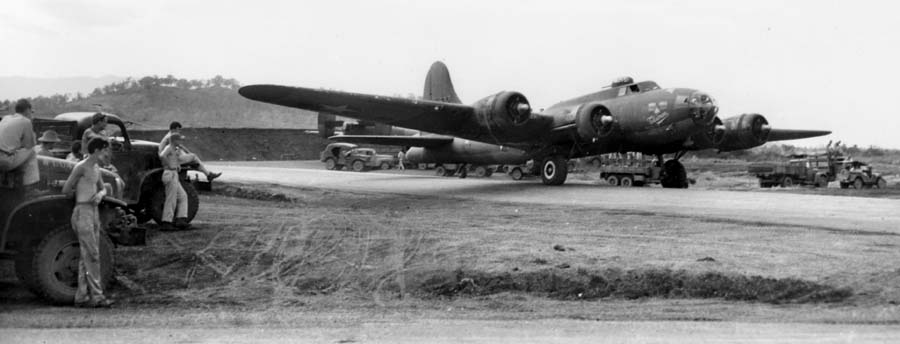
With plenty of enemy targets available, four B-17s from the 63rd BS took off to strike Tonolei Harbor at 1:30 am on November 12. Flying the buddy system, the flight broke into pairs, with one pair attacking the transports on the west side of the harbor while the other pair struck the ships on the east side. Approaching at 2,000 feet, Lieutenant Murphy in B-17F #41-24384 (Pluto) spotted the phosphorescent wake of a 10,000-ton transport moving across the harbor and dropped down for a skip bombing run. “When I leveled off at 200 feet, I picked up the wake of the ship,” reported Murphy. “As I moved closer, the ‘X’ mark [I had scratched] on my window met the middle of the ship. I called, ‘Bomb, bomb, bomb, bomb.’” With each command, Murphy’s bombardier toggled loose a bomb. As Plutopassed over the ship, the antiaircraft guns belatedly opened fire. “Our bombs had been delivered very accurately,” Murphy continued. “The transport was immediately on fire—explosions were seen on board, and [wingman, Captain Byron] Heichel and his crew confirmed that it had turned on its side.”
On the other side of the harbor, the other pair of pilots was having similar luck. Also using skip bombing, Captain Ed Scott hit an 8,000-ton cargo ship with two bombs, causing substantial damage, while Captain Folmer Sogaard, flying B-17F #41-24520 (Fightin’ Swede), sank a 10,000-ton transport with one bomb amidships and two more on the waterline.
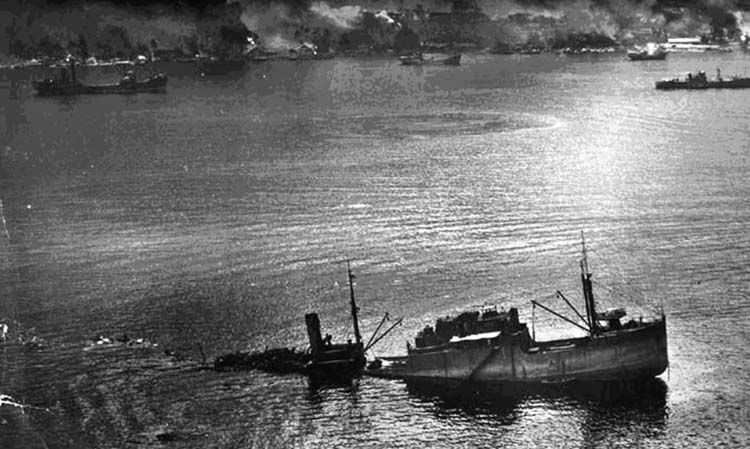
The next night, Lieutenant Murphy, still flying the Pluto, and his wingman Captain Heichel, set out from Port Moresby at 1 am for another raid on Tonolei Harbor. The two ran into a violent storm that had the crews “holding their breaths that the engines would continue running” between New Guinea and Bougainville but managed to reach the harbor just as the moon was rising.
Spotting a 10,000-ton cargo ship, Murphy was just starting his descent for a skip bombing run when an antiaircraft shell hit his No. 4 engine. Quickly feathering the propeller, Murphy steadied Plutoat 200 feet and skipped two 1,000-pound bombs into the ship. “We then flew over a runway and became the target for more antiaircraft fire, “he wrote. “There was another 8,000-ton cargo vessel at the harbor by the runway, so we dropped the other two 1,000-pound bombs and hit the ship; fire erupted immediately.” A second later, an antiaircraft shell tore a two-foot hole in the upper left side of Pluto’s Plexiglas nose.
“It felt as though we were in a hurricane,” Murphy said as the airstream rushed in through the hole. “Everything was flying around in the nose and up in the cockpit.” In spite of the hole in the nose and the loss of partial power in another engine, Murphy successfully brought Plutothrough the same violent storm that he had faced on the way out and managed to land safely at Port Moresby. “The crew really took a physical pounding,” he reported, “and I still have great praise for the ability of the Boeing Flying Fortress to take punishment.”
Throughout the rest of November, the Fifth Air Force concentrated on aiding the Allied drive against the Japanese strongholds of Buna and Gona on the northern coast of New Guinea. Whenever enemy ships were spotted bringing supplies or reinforcements to the two bastions, Kenney’s men attacked. After sunset on November 24, a convoy of five Japanese destroyer transports was spotted making a run toward Buna. While most of the seven B-17s of the 63rd and 65th Bomb Squadrons attacked from low altitude, damaging two ships and sinking the Hayashio,Captain McCullar, in the Black Jackonce again, went in at 200 feet and skipped a couple of bombs against the stern of another destroyer. “The bombs hit just off the end of the boat,” McCullar reported, “and the AA [antiaircraft] hit in [our] tail gunner’s ammunition can exploding about 70 shells and starting quite a fire.” While McCullar circled for another bomb run, the crew frantically extinguished the fire.
Staying at 200 feet, McCullar hit the destroyer again, “starting a fire on the right front of the ship.” Again, antiaircraft fire hit McCullar’s Fortress, wounding two men and damaging the No. 1 engine. Climbing to 4,000 feet, McCullar went over the burning vessel one last time and dropped his last few bombs, which fell harmlessly into the sea. When another burst of antiaircraft fire took out the No. 3 engine, McCullar feathered the propeller and headed Black Jackback to Port Moresby. At the same time, the badly damaged Japanese convoy, less the Hayashio, headed back to Rabaul.
The Fifth Air Force B-17s continued to use skip bombing against Japanese ships whenever possible, with Captain McCullar leading the way. Promoted to major on January 16, 1943, McCullar was given command of the 64th BS and quickly started training his men in the techniques of skip bombing. Noted the squadron historian, “Capt. McCullar inspired the officers and men with his flying tactics. The Capt. was a skip-bombing expert.”
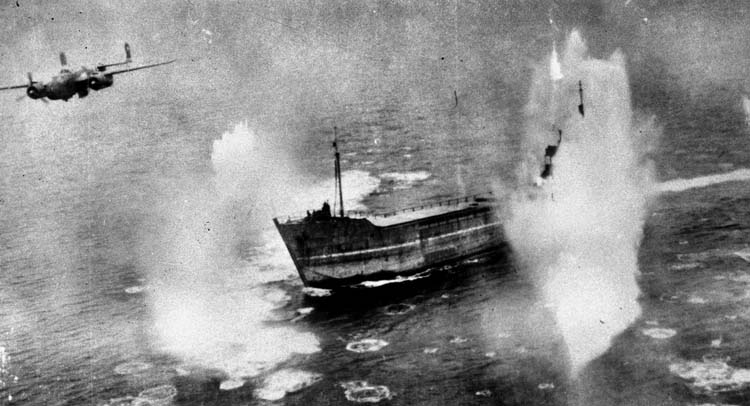
Although skip bombing with a B-17 had been proven successful, General Kenney felt that the lack of forward firing guns in the nose of the Flying Fortresses limited their ability to do damage against the enemy vessel prior to the bomb strike. Because of this, he had Colonel Paul I. “Pappy” Gunn begin modifications on the lighter, faster North American B-25 Mitchell medium bombers of his 3rd BG. Eventually, Gunn mounted 10 forward-firing .50-caliber machine guns in the nose and alongside the fuselage of his B-25s.
In early March 1943, the Japanese put up a maximum effort to reinforce their garrisons on New Guinea, sending out eight destroyers, seven transports, and one special service vessel carrying the Japanese 51st Division. Spotted in the Bismarck Sea on March 2, the Japanese were soon under attack by hundreds of Allied planes.
Among the first to reach the convoy were seven B-17s of the 63rd BS. While five of the planes attacked from about 4,000 feet, Lieutenant Murphy in B-17F #41-24381 (Panama Hattie) and his wingman Captain Sogaard in the Fightin’ Swedewent down to skip bomb the transports. Spotting the 8,000-ton Kyokusei Maru, Murphy battled through the heavy antiaircraft fire of the protecting destroyers to hit the transport squarely amidships. “I turned the plane around, dropped closer to the water, and saw one end of the transport pointed towards the sky,” he wrote. “The ship had been split apart and was sinking.” Not to be outdone, Sogaard skip bombed a 5,000-pound transport, stopping her dead in the water.
During the rest of the day and into the early evening, the B-17s continued to attack the remaining vessels, although they dropped their bombs from about 4,000 feet and scored few hits. The next morning, March 3, 1942, a total of 106 Allied planes, both Australian and American, prepared to hit the convoy in waves. While the B-17s of the 43rd BG scored a number of hits from low altitude, the most successful attack came from 12 of Colonel Gunn’s B-25 medium bombers that came in low using skip bombing and hit 11 different ships, sinking one destroyer and one transport. The next day, the B-25s went in at masthead level again and sank two more destroyers and severely damaged two transports.
The Battle of the Bismarck Sea ended on March 4 as a resounding victory for the Allies. For the loss of three fighters, one B-17, and 13 airmen, the Allies had stopped the Japanese dead in the water, sinking all seven transports, one service vessel, and four destroyers, with a total loss of about 3,000 men. Although the B-17s had played a big part in the battle, being credited with sinking six ships, it was the B-25s that had shown their effectiveness at skip bombing against moving ships in broad daylight.
Lighter and faster than the B-17s, the twin-engine B-25s and their counterparts, the twin-engine Martin B-26 Marauder medium bomber and the Douglas A-20 Havoc light bomber, were highly maneuverable and made small targets when coming in at masthead level against an enemy vessel. Armed with multiple forward-firing machine guns and even cannons, the B-25s, B-26s, and A-20s could do plenty of damage to a Japanese ship before they ever got close enough to skip their bombs across the surface of the water.
Although the B-17 would continue to be used in both high- and low-level attacks for a few more months, its time in the Pacific was drawing to a close. As the Allies began to win the war in the Pacific, employing the “island-hopping” strategy to moved ever closer to Japan, the longer range B-24s began to replace the shorter range B-17s. By the end of 1943, the B-17 was no longer being used for combat missions in the Pacific. By that time, Major Benn was no longer around. On January 18, 1943, he had gone out in a B-25 on a reconnaissance mission. The plane never returned.
Although the B-17 was gone from the Pacific, the big Flying Fortress had pioneered the skip bombing technique and had proven to the world that skip bombing was a viable tactic, one that would be used repeatedly by the crews of the smaller, faster twin-engine bombers until Japan surrendered on September 2, 1945.
Gene Eric Salecker is a retired university police office who teaches eighth-grade social studies in Bensenville, Illinois. He is the author of four books, including Blossoming Silk Against the Rising Sun: US and Japanese Paratroopers in the Pacific in World War II .He resides in River Grove, Illinois.
